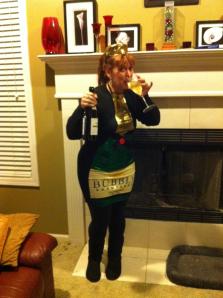The new year is on our doorstep. Time for cheap party favors, resolutions we’re pretty sure we won’t keep, and the sound of a million corks popping to pour those delightful little bubbles. But how do you know which bottle of bubbly is the right pick for you? All bottles of Champagne are not the same…in fact, some aren’t Champagne at all! But that doesn’t mean they aren’t perfect. With all of the choices available, it’s tough to know which bottle is pop-worthy for you. Hopefully this Bubbles 101 primer will help you sort through the selections to help you make the best choice for your personal taste.
First of all, true Champagne is only from the Champagne region of France. Now that doesn’t mean that other places don’t make the same type of bubbling wine…it’s just they can’t call it Champagne unless it’s from that French region. Whether from Champagne, California, Spain…wherever…if it’s made using the ‘Methode Champenoise’ process, you’ll find it to be the traditional sparkling wine we’ve all come to know and love to celebrate the new year. Look for that process and you’re one step closer to picking the perfect bottle.
Another process to look for is the Charmat method. All that means is that the fermentation to turn it into bubbly was done in a stainless steel tank instead of in the bottle you will pour it from. For most people, it won’t really make any sort of a difference. You’ll find this done with a lot of Italian sparklers.
Next lesson in bubbly is how to pick one that meets your sweetness preference. Much like still wines, it can run the gamut. Here are the words to look for to help you pick the right level of sweetness for your tastes.
Ultra Brut/Extra Brut/Brut Zero/Brut Nature/Brut Sauvage: No added sugar
Brut: Nearly dry, contains no more than 1.5% sugar.
Extra Dry/Extra Sec: Slightly sweeter, can contain up to 2% sugar.
Dry/Sec: Can contain up to 4% sugar
Demi-Sec: Just sweet enough, can contain up to 8% sugar.
Doux: Sweet, can contain up to 10% sugar
Okay, so now you know what to look for in sweetness. Now it’s time to figure out exactly what sort of grape is in that bottle you’re picking up.
If you’re getting a true French Champagne (only from the Champagne region), you’re going to find only three types of grapes: Chardonnay, Pinot Noir, and Pinot Meunier. If it’s made from Chardonnay, it will be called ‘Blanc de Blancs’. If it’s made from one of the other two, it’s ‘Blanc de Noir’. All it means is that one is a ‘white grape’ (the skin of the grape) and the others are ‘dark grapes’. It doesn’t effect the color of the wine.
Rose (or pink) Champagnes/Sparkling Wines are simply made by adding a small amount of still red wine which gives it a little bit of sweetness.
Look for other French sparklers under the name ‘Cremant’ or ‘Mousseux’. These bubblies can be made using other types of grapes such as Chenin Blanc, Cabernet Franc, Pinot Blanc, or Pinot Gris. Cremants are thought to be ‘creamier’ rather than ‘fizzy’ and are made in the traditional way. Mousseux uses the tank method. My favorites are the Cremant d’Alsace. Amazing wines!
U.S. Sparkling wines are made using the same grapes (typically) used in the Champagne region. In fact, they’re often made by the same Champagne houses you find in France. They just have set up shop in the U.S. Mainly California.
Want something a little more exotic? Why not try a Sparkling Shiraz from Australia? Most are somewhat sweet, but some of the producers will turn it into a dry, full-bodied, tannic wine.
Spanish Cava uses the Macabeo, Parellada, Xarello, and sometimes Chardonnay grapes. They are made from dry to sweet so everyone has something to love.
German Sekt is made from Riesling, Pinot Blanc, Pinot Gris, or Pinot Noir.
Italy also gives us a few sparkling beauties. Asti is a sweet sparkling wine made from the Muscat grape. It’s typically low in alcohol at around 8%. Great sipper. You’ll find it called Spumante. A lighter fizzed, lower alcohol version is also produced (called Frizzante). Moscato d’Asti is even sweeter than the Spumante and sits at around 5% alcohol, so you can get your toast on without it knocking you for a loop after a glass.
Franciacorta is typically made in the Blanc de Blancs style if you want more of a traditional pour from Italy.
One of my personal favorites is Prosecco, named after the grape from which it’s made. It’s made in both the Spumante and Frizzante styles and are typically dry in nature. They’re the primary ingredient in the Bellini…a brunch cocktail favorite!
One other absolute favorite of mine from Italy is Brachetto d’Acqui…a sweeter frizzante in a BEAUTIFUL ruby color. Inexpensive, festive, pairs well with foods and desserts or works well on it’s own. I sip it regularly year round.
Okay, have I confused you enough? Have you got all of your notes and are feeling well prepared to grab a bottle, pop the cork, and toast a new year? However will you choose?
My best piece of advice on that one: trust your gut, explore and try something new, and share with friends. That’s the best choice every time.
Celebrate well, my friends, sip responsibly, and here’s to another wonderful year to come.
Cheers!
~CC
